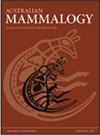南澳大利亚温带地区兔耳袋狸的穴居习性
IF 1.2
4区 生物学
Q3 ZOOLOGY
引用次数: 1
摘要
大兔耳袋狸(Macrotis lagotis)的残余自然种群被限制在澳大利亚的干旱地区,在那里,兔耳袋狸在它们的家园范围内建造和庇护多个洞穴。我们在澳大利亚南部温带地区的一个易地种群中调查了兔耳袋狸的洞穴使用行为,以确定这种行为是否在这个气候带有所不同。在12个月的时间里,研究人员对金星湾自然保护公园的43只成年兔耳袋狸进行了118个洞穴的跟踪调查。活动洞穴密度为每公顷0.55个,该地点的兔耳袋狸使用多个洞穴(雄性多达13个,雌性多达8个),并定期在日间洞穴之间移动。雄性兔耳袋狸的洞穴范围(10.2±5.8 ha, MCP100, mean±s.d)明显大于雌性兔耳袋狸(2.6±1.8 ha),其大小与干旱区种群相似。雄性的洞穴范围倾向于与多个其他雄性和雌性的洞穴范围重叠。目前研究中洞穴的密度表明,兔耳袋狸在当地灭绝之前,洞穴可能是该物种范围南部地区的常见景观特征。需要进一步的研究来确定南澳大利亚兔耳袋狸洞穴的消失对其他洞穴共生物种的影响。本文章由计算机程序翻译,如有差异,请以英文原文为准。
Burrow use by bilbies in temperate South Australia
Remnant natural populations of greater bilbies (Macrotis lagotis) are confined to the Australian arid zone where bilbies construct and shelter in multiple burrows within their home range. We investigated burrow use behaviour of bilbies in a translocated population in temperate southern Australia to determine if behaviour differed in this climatic zone. Over a 12 month period, 43 adult bilbies at Venus Bay Conservation Park were spool-and-line tracked to 118 burrows. Active burrow density was 0.55 per ha, and bilbies at the site used multiple burrows (up to 13 for males and 8 for females) and regularly moved between diurnal burrows. Male bilbies had significantly larger burrow ranges (10.2 ± 5.8 ha, MCP100, mean ± s.d.) than females (2.6 ± 1.8 ha), and were similar in size to those recorded in an arid zone population. Males’ burrow ranges tended to overlap with the burrow range of multiple other males and females. The density of burrows in the current study suggests that bilby burrows were likely to have been a common landscape feature within the southern parts of the species range prior to their local extinction. Further research is needed to determine the impact of the loss of bilby burrows from southern Australia on other burrow commensal species.
求助全文
通过发布文献求助,成功后即可免费获取论文全文。
去求助
来源期刊

Australian Mammalogy
ZOOLOGY-
CiteScore
2.50
自引率
8.30%
发文量
26
期刊介绍:
Australian Mammalogy is a major journal for the publication of research in all branches of mammalogy. The journal’s emphasis is on studies relating to Australasian mammals, both native and introduced, and includes marine mammals in the Antarctic region. Subject areas include, but are not limited to: anatomy, behaviour, developmental biology, ecology, evolution, genetics, molecular biology, parasites and diseases of mammals, physiology, reproductive biology, systematics and taxonomy.
Australian Mammalogy is for professional mammalogists, research scientists, resource managers, consulting ecologists, students and amateurs interested in any aspects of the biology and management of mammals.
Australian Mammalogy began publication in 1972 and is published on behalf of the Australian Mammal Society.
 求助内容:
求助内容: 应助结果提醒方式:
应助结果提醒方式:


